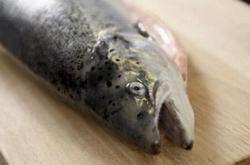
And it’s not just the salmon, it’s the country’s king crab, scallops and cod, too.
The world’s second-largest seafood exporter has been shipping fresh and frozen seafood into Indonesia since 1988, and is making an aggressive push to be better known in the region.
“The demand in Southeast Asia is growing and it is inspiring to see,” said Christian Chramer, regional director of the Norwegian Seafood Council in Southeast Asia. “The economy is growing, there is increased infrastructure and retail growth.”
According to the council, Indonesia imports 79 tons of Norwegian seafood a week on average, 40 tons of which is salmon. Globally, Norway sends out 17,250 tons of salmon per week.
In total last year, Indonesia imported a little more than 4,000 tons of Norwegian seafood, 2,067 tons of it salmon.
With frequent deliveries to the capital, it has become easy to taste the quality of Norwegian seafood from Jakarta’s many fine hotels, restaurants and grocery stores.
As part of an initiative to familiarize Indonesia with Norway’s second-biggest export, the council sponsored a media trip to Norway, bringing journalists from Indonesia face-to-face with its fisheries industry.
It has also brought in Norwegian chefs for master classes in Jakarta, including one attended by Crown Prince Haakon Magnus and his wife, Crown Princess Mette-Marit, who were passing through on an official state visit.
The most recent was a master class led by Culinary Olympics gold medalist Sven Erik Renaa for some of Jakarta’s best chefs and culinary students.
Renaa showed attendees some of his innovative dishes, featuring prime examples of Norwegian seafood such as his lightly smoked Norwegian halibut, Norwegian king crab and oyster “linguini,” and his Norwegian salmon tartar with avocado “flying carpet” and vendace roe.
But beyond taste, the council wants to promote the health benefits of a diet including seafood. Renaa began his presentation with a briefing about food safety and how to handle the imported seafood.
Norway sends both frozen and fresh seafood to Indonesia. Fresh seafood can arrive in Jakarta within 48 hours, but if not handled correctly and preserved at the right temperatures, it can go bad.
Health benefits were also part of the media trip to Norway. The trip included a presentation from Livar Froyland, director of the National Institute of Nutrition and Seafood Research, who explained the science behind Norway’s seafood industry and the benefits of fish as part of a daily diet.
Froyland said after years of seafood research that it was now well-established that a diet featuring fish can protect against cardiovascular diseases, while there is also emerging evidence that fish can help with mental health, brain development and depression.
He encouraged people to actually eat seafood instead of taking supplements, in view of the added health benefits.
Replacing a red meat main protein with fish not only boosts Omega-3, iodine and protein intake, but also cuts out saturated fat.
Froyland addressed the fears associated with eating too much salmon or herring — namely mercury poisoning or ingesting other undesirables.
“Negative news is much more interesting,” he said, adding that the media had blown the “bad stuff” out of proportion.
“You would need to eat 1 kilogram to 1.2 kilograms every week to go over the [tolerable weekly intake],” he said. “And no one is eating that much.”
Froyland also covered the specific factors that made Norway’s farmed fish of particularly high quality.
Although considered inferior to wild salmon, Froyland argued that farmed salmon could actually be healthier, as it is easier to monitor the health of farmed fish or catch other wellness-related issues compared with their wild brethren.
Farmed fish are fed pellets that can be adjusted to provide optimal nutrients to the fish.
Norway has the second-largest farmed fish industry after China, and it takes its industry seriously.
Chramer said the Norwegian government observed strict regulations on salmon pens at farms: Each pen can only have a maximum of 2 percent fish, so the rest of the space, at least 98 percent, is open water for humane reasons.
Every farm must be licensed by the government and they are routinely inspected to ensure they are up to code. Even the number of harvests is regulated to ensure that the industry stays responsible.
But it is not just regulations and rules that make Norway a seafood expert.
Chramer said the country has three major, interconnected advantages in the seafood industry: its nature, history and sustainable management.
Norway’s location far to the north makes it ideal. The seas are cold, clear and can be very rough, which salmon prefer.
“Norwegians have been fishing and producing fish for hundreds of generations,” Chramer said.
This long history of working with and understanding the environment has made Norwegians experts in the fishing industry, he added. Building on a deep relationship with and understanding of their environment, Norwegians have placed a strong emphasis on sustainablity.
“It is becoming more and more important and can even be stronger with more awareness,” Chramer said.





